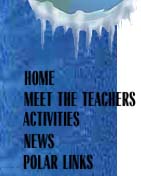
|
|
Annual Report for Elke Bergholz
1999
Back to Main Page
1. Research Interaction
Field Experience
Additional Comments:
Time on the ice: South Pole Station
a) Regular email contact with all schools and classes visited
- additional regular contact with Little River School from Texas,
International School in Venezuela, Elementary school in Toronto, Many other
contacts across the country;
total emails( not including personal) 400
b) CUSeeMe established in collaboration with CARA project at the South
Pole; regular conferences with 3 schools, all call was not as successful
since the South Pole was said not to be prepared. By the time I was ready
for an all call 3 school in addition attempted but were not successful.
Sandy Kolb parcticipated, however her school was not successful in
connecting. Regular CuSeeMe with my classes. Filming by CBS in my classroom (copy to be mailed) in conjunction with CBS
interview at the Pole.
c) Submitting of ozone data to 180 teachers/institutions/schools/people
Several delivery lists had to be established.
d)Parcticipation in research: ozonesonde ballooning, twice a day, every
other day for two weeks, once a week thereafter. Dobson measurements, C02
flask sampling
e) journal writing:
Very good feedback about the information and as well as personal tone.
Continued Collaboration with Reasearch Team Members
2. Community / Colleague Outreach
Classroom Transfer
How are you sharing your research experience with students?
- visiting Meriell Elementary School In Christchurch, NZ
presentations to 4 different groups: total number of students 100 - 125
- UNIS/Manhattan additional class
junior 3 : 120 students
- follow up presentations to all grades:
Grade 12 : 130 students
- - other presentations and follow up visits are scheduled.
- display of the Antarctic Artwork in the lobby of the school
- Display of the schools Antarctic program at a bulletin board ( work of
all classes included with dates of my class presentations)
- School paper: Antarctic program
- Website Publication UNIS and Marymount School
- continuation of ozone activities in the class room
- completing display in the classroom , Taken photos of some class
activities.
- Continuation of mentoring program with 3 teachers at Marymount
- Continiued use of ozone data in my class room and submitted new ozone
data to other schools
- Submitting activity information to other tachers, via email or after
school visits
- Presentation of antarctic experience and antarctic activities to other
teachers in
- my schools
- public schools in New York, Doxbury,Ma, Marthars Vinehard, MA
- Teachers workschop for prof. development at the Am. museum of NAtural
History
- NSTA Boston
- Planet Earth Teachers workshop, AMNH
- Activity workshop
- two town presentations including teachers in Wismar and Neukloster,
Germany, presentation with matarial
- NABT, Forth Worth, hands-on workshop
- Science weekend in New York for Juior and Middle school teachers(ECSW),
hands-on work shop
- Environmental Educational Advisory Committee (EEAC)
- AGU
- Introduction to NSF programs to teachers: Research use in the classroom,
"On the Brink" science lecture At the Y92nd street. Pre teacher meeting to
Rita Corell's presentation 12/24/00
- Teacher, parent, students, alumni, trustees Antarctic Evening At UNIS,
presentation with material
(fall 1998)
a) UNIS/ Manhattan ( direct contact 725 Students)
Junior 4( 4th grader): 120 students
Middle 2 ( 6th grader): 100 students
Middle 3 ( 7th graders) 125 students
TUT1 (grade 9) : 100 students
TUT 2 (grade 10): 50 students
TUT 3 ( Grade: 11):70 students
TUT4 ( Grade 12): 70 students
classes visited: Science(Science, geography, art, contemporary issues)
b) UNIS/ Queens
Grades 1 - 8 assembly: 150 students
c) Marymount School Of New York: ( 90 students)
Grade 3: 20
Grade: 5: 20
Grade : 10, Chemistry: 40
d) Museum School, IS 44, At the Museum of Natural History
Grade 6, 7, 8, : 2 assemblies: 200 students
e) Computer School, PS 87
Grade 6,7,8 assembly: 200 students
f) PS 40:
grade 3 + 5: 50 students
g) Charter School of Martha's Vineyard
Grades 3 - 12: all day visits in 5 class groups: 100 students
Total number of student reached in direct contact: 1515
TEA information packages to teachers and
schools
a) Tea information folders:
- (Antarctic Booklet, Bibliography list, activity list, ozone computer
activity, NSF Polar program information, NOAA middle school ozone activity
package, ozone web sites information, class room material summery, ozone
press release, student information sheet)
- 150 folders were given to teachers at presentations or mailed to teachers
in different parts in the country and outside the country ( New Zealand,
Venezuela, Canada, Brazil, Germany) (150 teachers)
Will mail a sample to NSF and NOAA. ( Wayne Sukow, Dave Hofmann)
b) TEA information envelops:
- 50 envelops mailed to Woodrow Wilson Fellow of 1996, with TEA
information, student information sheet, ozone information, ozone web site
information, research time at the South Pole. ( 50 teachers)
c) Electronic Information about TEA and my deployment on the ice to all
Access Excellence Fellow (300 teachers)
Written information
to UNIS community:
- information sheet to all members of the community:
1200 students, Administrators, Faculty, support staff
- Letter to the New director for the UNIS web site for publication (see scrap book)
- Newspaper publication with the TEA website information to 50 New York City Schools
Mentoring/Collaborative Mentoring Team
Associates Network
Type of Interaction:
Mentoring started with 2 middle school teachers in the spring of 1998 and continued in the fall, has been continued since my return. Additional mentoring possible with a teacher at Marymount.
Presentations and Real Audio Sessions
3. Classroom Transfer
Activities Development
Title:
Ozone Activity
Description:
Students examine Antarctic ozone data
Have these activities been submitted to the Web for posting?
Yes
4. Other TEA Activity Involvment
Activity:
5. Cost Share
Release Days
TEA Meetings Covered by School/District
Equipment Provided by Institution/Corporation/District
Other Grants
Other Shared Costs
6. Anticipated TEA Involvement (01/2000 to 01/2001)
|

